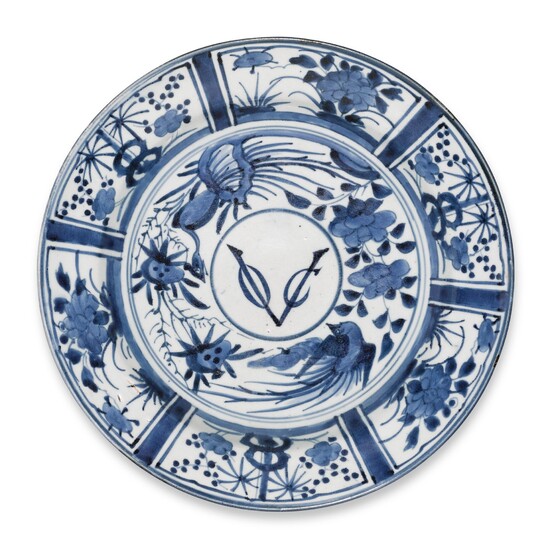AN ARITA DISH ORDERED FOR THE DUTCH EAST INDIA COMPANY EDO PERIOD, LATE 17TH CENTURY
AN ARITA DISH ORDERED FOR THE DUTCH EAST INDIA COMPANY EDO PERIOD, LATE 17TH CENTURY
the circular dish with wide rim decorated in underglaze blue with a central roundel depicting the initials of the Dutch East India Company “VOC” (Vereenigde Oostindische Compagnie), surrounded by birds among foliage, bordered by six panels of flowers
36.5 cm., 14.3 in. diam.
Provenance:
Dishes with the VOC monogram demonstrate the role of the East India Company trade in East-West relations. The dishes are not mentioned in trade documents but were probably specially ordered for use by company staff at the factory on Deshima and other factories in Asia including Batavia.
For a similar example in the Ashmolean Museum Oxford, see: John Ayers, Oliver Impey and J.V.G. Mallet, Porcelain for Palaces, the Fashion for Japan in Europe, 1650–1750, an exhibition organised with the British Museum, (London, 1991), no. 32 p.94; in the Metropolitan Museum of Art, see: Martin Lerner, Blue and White, Early Japanese Export Ware (New York, 1979), no. 59, and see: Oliver Impey, The Early Porcelain Kilns of Japan (New York, 1996), p. 11.
For further discussion on this style of dish see: C. J. A Jörg, Interaction in Ceramics, Oriental Porcelain and Delftware (Hong Kong, 1984), pl. 63, p. 108.
For a similar example, see Soame Jenyns, Japanese Porcelain, (London, 1965), pl. 14.B.
View it on
Estimate
Time, Location
Auction House
AN ARITA DISH ORDERED FOR THE DUTCH EAST INDIA COMPANY EDO PERIOD, LATE 17TH CENTURY
the circular dish with wide rim decorated in underglaze blue with a central roundel depicting the initials of the Dutch East India Company “VOC” (Vereenigde Oostindische Compagnie), surrounded by birds among foliage, bordered by six panels of flowers
36.5 cm., 14.3 in. diam.
Provenance:
Dishes with the VOC monogram demonstrate the role of the East India Company trade in East-West relations. The dishes are not mentioned in trade documents but were probably specially ordered for use by company staff at the factory on Deshima and other factories in Asia including Batavia.
For a similar example in the Ashmolean Museum Oxford, see: John Ayers, Oliver Impey and J.V.G. Mallet, Porcelain for Palaces, the Fashion for Japan in Europe, 1650–1750, an exhibition organised with the British Museum, (London, 1991), no. 32 p.94; in the Metropolitan Museum of Art, see: Martin Lerner, Blue and White, Early Japanese Export Ware (New York, 1979), no. 59, and see: Oliver Impey, The Early Porcelain Kilns of Japan (New York, 1996), p. 11.
For further discussion on this style of dish see: C. J. A Jörg, Interaction in Ceramics, Oriental Porcelain and Delftware (Hong Kong, 1984), pl. 63, p. 108.
For a similar example, see Soame Jenyns, Japanese Porcelain, (London, 1965), pl. 14.B.



